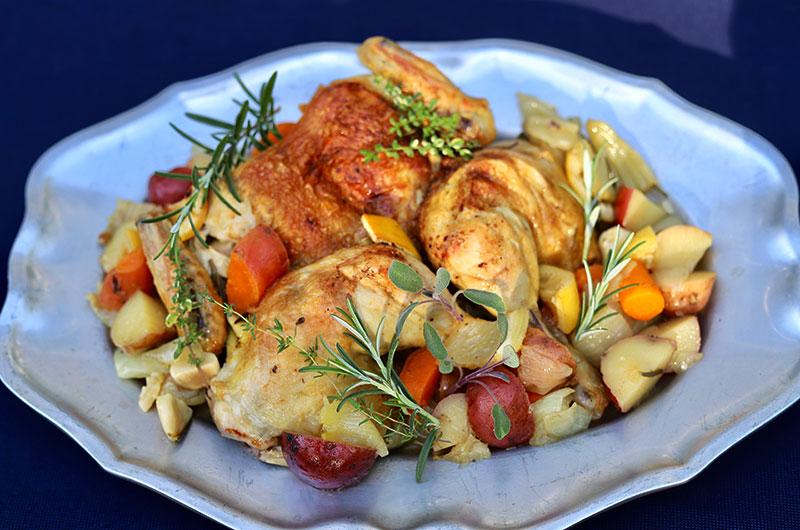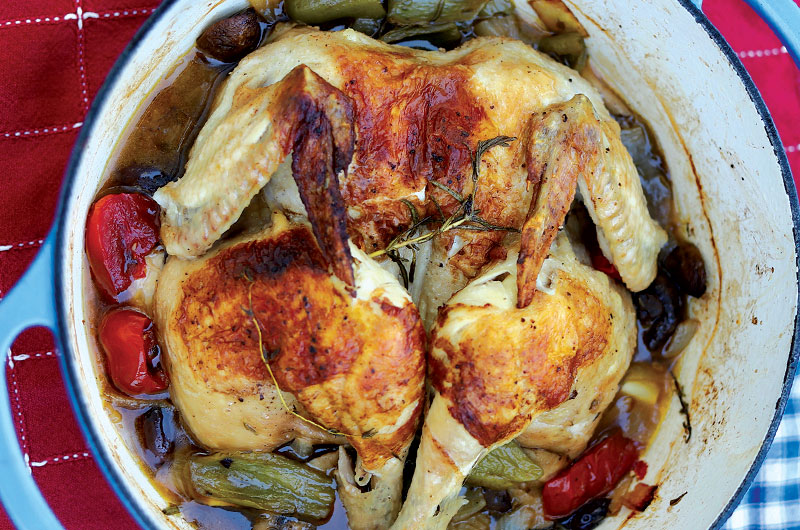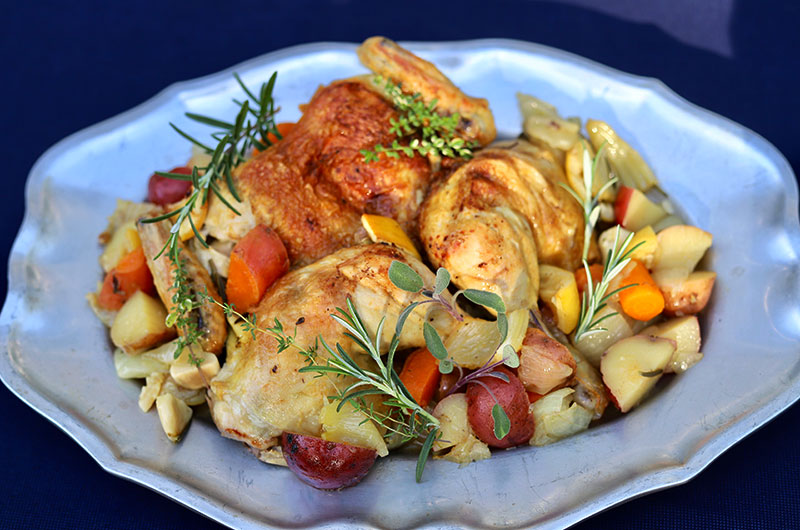Last year, my significant other gave me what every cook wants for Christmas: a Le Creuset enameled cast iron Dutch oven. A big one. Fire-engine-red. Someone joked that it was insurance against me returning to vegetarianism. But I choose to think otherwise. He knew I wanted one.
The first thing I did with that pot was to cook a whole butterflied chicken in it, with the lid on – with a bunch of lemons and garlic and herbs tossed in the pot too. Sort of chicken pot roast. (No, I didn’t make chili for forty or braise twelve lamb shanks.)
I browned the chicken first, skin side down, in the pot on the stovetop. Then, using tongs, I turned the bird over, lifted it up, and threw the mélange of veggies and herbs underneath. I nestled the bird back into the vegetables and covered the pot. I put it in a 350-degree oven and cooked the chicken for about an hour and fifteen minutes. I think that was a smallish broiler chicken, maybe just shy of four pounds, so it fit with room to spare.
Between the juices in the bird, the moisture the vegetables released, and the tight-fitting lid, the atmosphere in that pot was pretty steamy, to say the least. The chicken came out so very tender and moist that I wondered if I’d ever again roast a whole chicken in the traditional way (uncovered in a shallow pan).
I repeated this method a few times over the winter, sometimes with cut-up sweet potatoes in the pot, other times carrots or potatoes. The sweet potatoes tended to get a little too soft, but I didn’t mind because all the other aromatics (including onions, garlic, and herbs) combined with the juices to create a wonderfully aromatic elixir in the bottom of the pot. Everything tasted good.

This September, as the weather began to cool, I tried the method with a couple different local chickens. One from Morning Glory Farm in Edgartown weighed in at almost five pounds, the other from The GOOD Farm in Vineyard Haven at four-and-a-half pounds. Both had been slaughtered the week I cooked them, so they had never been frozen. Not only did the moist cooking and the fresh chicken produce incredibly tender meat, but both of these local chickens were deeply flavorful, with true “chickeny” flavor.
During all this testing, we varied the mix of veggies and herbs we used and discovered that our favorite combination was mushrooms, peppers, black olives, and plum tomatoes. Because of the tomatoes, that combo produces more broth (a.k.a. pot liquor) than the original combo of root veggies, fennel, and lemon. Makes a good excuse for bread, too.
This seems like a good time to bring up a couple of teensy problems with this method. First, you do need a big pot. But I’m happy to say you don’t need a giant pot. I cooked the four-and-a-half-pound bird in a round six-quart Dutch oven that measured about ten inches across the top and nine on the bottom. That chicken lay mostly flat in the bottom of the pan for the initial browning. Another slightly larger chicken didn’t lay completely flat, but it browned enough anyway. (The chicken will actually continue to brown as it cooks, but the initial browning gives it a jump-start and contributes to the eventual flavor of the pot juices.)
The second little issue is the butterflying. Basically, you need to cut the backbone out of the whole chicken in order for it to lay flat. The easiest method (and, really, the only one I recommend) is to cut it out with a pair of sharp poultry shears. Starting at the neck end, use your shears to cut alongside the backbone down one side (you will encounter one bigger bone that needs to be cut through, but the shears can do it), then turn the bird around and cut down the other side.
With the backbone removed, the chicken will splay, but it won’t yet lay flat. With the skin side down, locate the cartilage that runs between the two breasts. Using a sharp knife, make a shallow cut right in the center of the end of the cartilage closest to the legs. Press down on the bird and that cartilage will pop up, allowing the bird to lay relatively flat. (Making this last cut technically means you are spatchcocking as opposed to butterflying. A YouTube video can help here!)
A happy alternative for those who don’t fancy butchery is to ask a butcher to do it. The GOOD Farm’s Jefferson Monroe will do it for you at The Larder in Vineyard Haven when you buy a chicken from him there. Butchers at Cronig’s and Reliable Markets will butterfly chickens for you too.
Why butterfly at all? Because the meat will cook much more evenly, as all the parts will have a chance to nestle in with the vegetables and liquids gathering at the bottom of the pot. Serving will also be easier.
Lastly, serving this chicken requires a little chutzpah – and either shallow bowls or rimmed plates – but everything is so tender that the leg and thigh pull right off the breast, and you can carve or pull the breast meat off the bone right in the pot. Put some meat in each serving dish, then spoon over the vegetables and some of the pot liquor. Yum.
Now that I’ve given you every reason not to make this chicken, let me say this again. You will love it.








